长沙地区低温粮仓双层通风屋顶最佳保温隔热层厚度分析
王海涛,王 军,郭呈周
长沙地区低温粮仓双层通风屋顶最佳保温隔热层厚度分析
王海涛,王 军,郭呈周
(河南工业大学土木建筑学院,郑州 450001)
粮仓围护结构保温隔热性能对储粮安全和粮仓能耗有重要影响。粮仓屋顶面积大,是粮仓围护结构接受太阳辐射最强的部位,外界热量主要通过屋顶传入粮仓,因此屋顶是粮仓围护结构保温隔热设计的最重要部位。双层通风屋顶、高反射率的屋面隔热涂料和保温隔热材料等节能技术近年来在粮仓屋顶设计中得到迅速发展和应用。考虑屋顶不同外表面太阳辐射反射率和自然通风对双层通风屋顶传热的影响,该文给出并试验验证了多层屋顶非稳态传热模型和双层通风屋顶传热模型,利用经过验证的屋顶传热模型进行屋顶能耗计算,采用经济性模型和全生命周期理论对长沙地区低温粮仓普通屋顶和双层通风屋顶最佳保温隔热层厚度进行分析,并对采用最佳保温隔热层厚度时的生命周期总投资、净收益及回收周期进行计算和比较分析。研究结果表明:屋顶外表面太阳辐射反射率对长沙地区低温粮仓屋顶最佳保温隔热层厚度和经济性有较大影响,双层通风屋顶可以减小屋顶最佳保温隔热层厚度,长沙地区低温粮仓可采用双层通风屋顶和高反射率的屋面隔热涂料降低粮仓能耗,减少因能源消耗而引起的环境污染问题。长沙地区低温粮仓普通屋顶挤塑聚苯乙烯和膨胀聚苯乙烯最佳保温隔热层厚度为0.106~0.183 m,生命周期内最大净现值为417~633.38元/m2,投资回收年限为2.39~2.96 a。低温粮仓屋顶最佳保温隔热层厚度随屋顶外表面太阳辐射反射率的增大而减小,双层通风屋顶可以减少屋顶保温隔热层投资回收年限。该屋顶最佳保温隔热层厚度确定方法对于指导低温粮仓屋顶保温隔热设计具有一定指导意义。
传热;保温层;模型;屋顶;太阳辐射;最佳厚度;生命周期
0 引 言
低温储粮是一种有效的绿色储粮措施[1],15 ℃以下的低温可以抑制害虫和微生物生长繁殖、保证粮食品质和减少粮食熏蒸的化学药剂污染[2]。提高粮仓围护结构保温隔热性能对于实现安全、经济、优质的低温储粮起着关键作用[3-4]。粮仓屋顶具有安全、隔热和防水的功能。粮仓屋顶面积大,是粮仓围护结构接受太阳辐射最强的部位,因此屋顶成为粮仓围护结构保温隔热设计最重要的部位。通过屋顶进入粮仓的热量是造成储粮温度偏高和影响储粮安全的最重要原因之一[5]。双层通风屋顶、高反射率的屋面隔热涂料和保温隔热材料等方法均是提高粮仓屋顶保温隔热性能的有效技术措施[6-15],保温隔热层厚度不但会影响低温粮仓制冷空调的能耗,而且会影响粮仓的建设成本。因此,研究低温粮仓屋顶最佳保温隔热层厚度,使粮仓整个生命周期内能耗费用与粮仓建设费用之和最小,可以确保储粮安全和实现粮仓节能减排,具有重要的工程应用价值和经济意义。
建筑围护结构保温隔热作为建筑节能的重要技术措施已经受到国内外学者的广泛关注[16-17]。目前绝大多数最佳保温隔热层厚度研究采用度日数法计算建筑能耗,利用生命周期法建立综合考虑建筑能耗费用和保温隔热材料成本的保温隔热层厚度数学模型,进而研究最佳保温隔热层厚度和节能效益[18-25]。仅有少量学者采用多层围护结构非稳态传热模型计算建筑能耗[17]。度日数法假定的空调系统运行时间与空调系统的实际运行时间不符,并且忽略了太阳辐射对建筑围护结构传热的影响,这将降低建筑围护结构能耗预测的准确性。采用生命周期法分析建筑围护结构建设成本时,没有考虑建筑围护结构的施工费用和其他相关费用,导致建筑围护结构建设成本分析具有片面性,最佳保温隔热层厚度预测的准确性降低。针对以上实际情况,本文以长沙地区为例,考虑低温粮仓空调系统运行及其能耗与普通居民建筑和公共建筑的不同,采用多层屋顶非稳态传热模型和双层通风屋顶传热模型进行能耗计算,并利用1-2经济性模型分析粮仓普通屋顶和双层通风屋顶的保温隔热层生命周期成本,分析预测长沙地区不同外表面太阳辐射反射率的粮仓屋顶和双层通风屋顶最佳保温隔热层厚度。
1 低温粮仓屋顶引起的空调能耗费用计算
1.1 粮仓多层屋顶非稳态传热模型

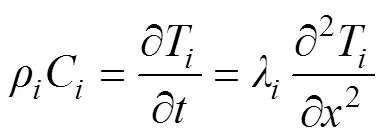
粮仓屋顶不同建筑材料层交界处的热传递方程可以用式(2)和式(3)表示。





1.2 粮仓双层通风屋顶传热模型
双层通风屋顶作为一种节能减排新技术在粮仓中得到了迅速发展。双层通风屋顶的自然通风降温机理已经被建筑热工界所认知。上层屋面得到的太阳辐射热量一部分以辐射和对流传热的方式传递到外界大气环境中,其余热量由上层屋面吸收后以辐射为主传递到下层屋面,上下2层屋面间空气层的自然通风气流会带走部分的屋顶传热量,将热量传递到外界大气环境中。图1给出了双层通风屋顶的传热机理示意图。
双层通风屋顶的传热数学模型可用式(6)表示。



式中是屋顶上表面的温度,K;是外界环境的空气温度,K;是双层通风屋顶的长度,m;d为双层通风屋顶的宽度,m;是上下2层屋面之间的距离,m;是屋面的倾斜角;是瑞利数;是局部努塞尔数;m为空气质量流速,kg/s。
分析式(7)和式(8)可知,影响双层通风屋顶自然通风气流带走热量的主要因素分别是屋顶上表面温度与外界环境空气温度之间的温差、屋面倾斜角、屋面长度和上下2层屋面之间的距离。
Olsson[27]给出了屋顶内侧空气温度计算公式。
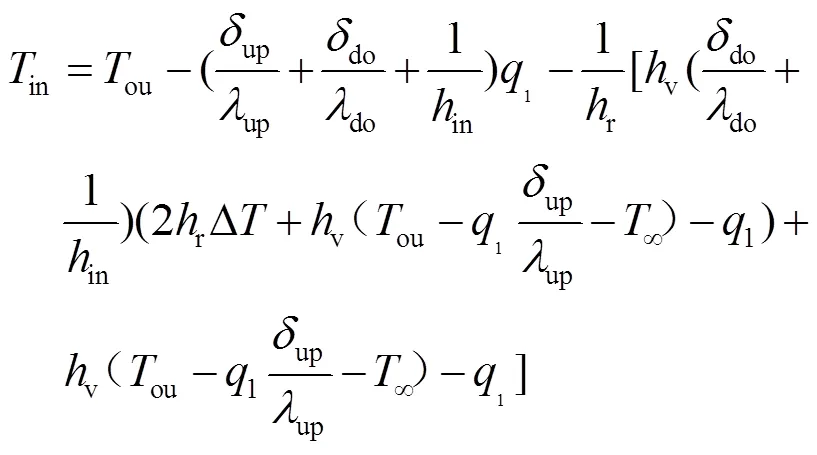
1.3 粮仓屋顶传热模型的试验验证
本研究采用对比粮仓屋顶内表面温度预测值和实测值的方法,验证粮仓屋顶传热模型的准确性。利用经过标定的LZ700型红外测温仪和数据记录仪自动采集长沙地区2017年7月29日0:00时至2017年7月30日24:00时2个粮仓的屋顶内表面温度数据,温度数据的采样时间间隔为10 min,共获得288组温度数据。屋顶内表面温度取坡屋面几何中心3个不同的相邻的测量点的温度平均值,温度测量点的间距为0.1m。验证试验涉及的粮仓普通屋顶为典型的粮仓屋面结构(细石混凝土40 mm+水泥砂浆20 mm+防水卷材4 mm+水泥砂浆20 mm+粉煤灰陶粒混凝土80 mm+钢筋混凝土350 mm)。验证试验涉及的双层通风屋顶的下层屋面为混凝土屋面板,上层屋面为红褐色瓦屋面。图2为高大平房仓双层通风屋顶剖面示意图。高大平房仓双层通风屋顶宽24 m,纵向高度7.5 m。
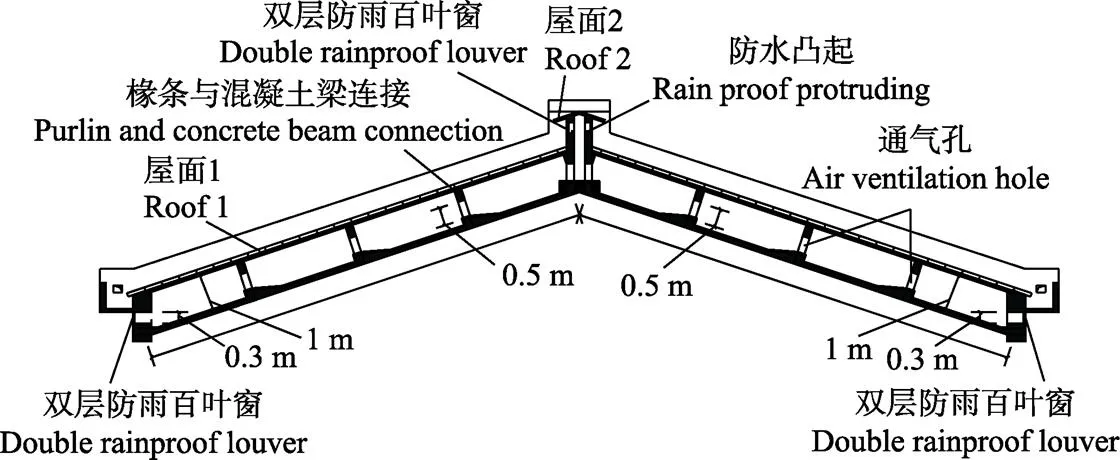
注:上下2层屋面之间的距离为1 m,单侧屋面长度为12.5 m,屋面的倾斜角度为30°。图中尺寸表示各通风孔高度。
在进行屋顶传热模型验证计算时,计算的时间步长取30 min,假设屋顶内各层建筑材料的初始温度相同,初始温度取2017年7月29日温度测量的平均值,通过对比2017年7月30日屋顶内表面温度测量值与模型预测值来验证粮仓屋顶传热模型的准确性。屋顶内表面对流换热系数取8.72 W/(m2·K),屋顶外表面对流换热系数取23.26 W/(m2·K)[3]。屋顶外表面的太阳辐射强度取屋面垂直壁面上的太阳辐射强度,其值可根据气象部门试验测得的太阳总辐射由Lam等[28]提出的分解公式计算获得。图3给出了粮仓屋顶内表面温度的模型预测值与实测值。由图3可知,屋顶内表面温度预测值与实测值之间的平均偏差小于5.5%,屋顶内表面温度预测值与实测值吻合良好。与实测值相比,多层屋顶动态传热模型的最大偏差为6.7%,平均偏差为4.6%。双层通风屋顶传热模型的最大偏差为8.2%,平均偏差为5.3%。验证结果表明屋顶传热模型的预测准确性较高,屋顶传热模型可用于分析和预测粮仓屋顶的空调冷负荷。
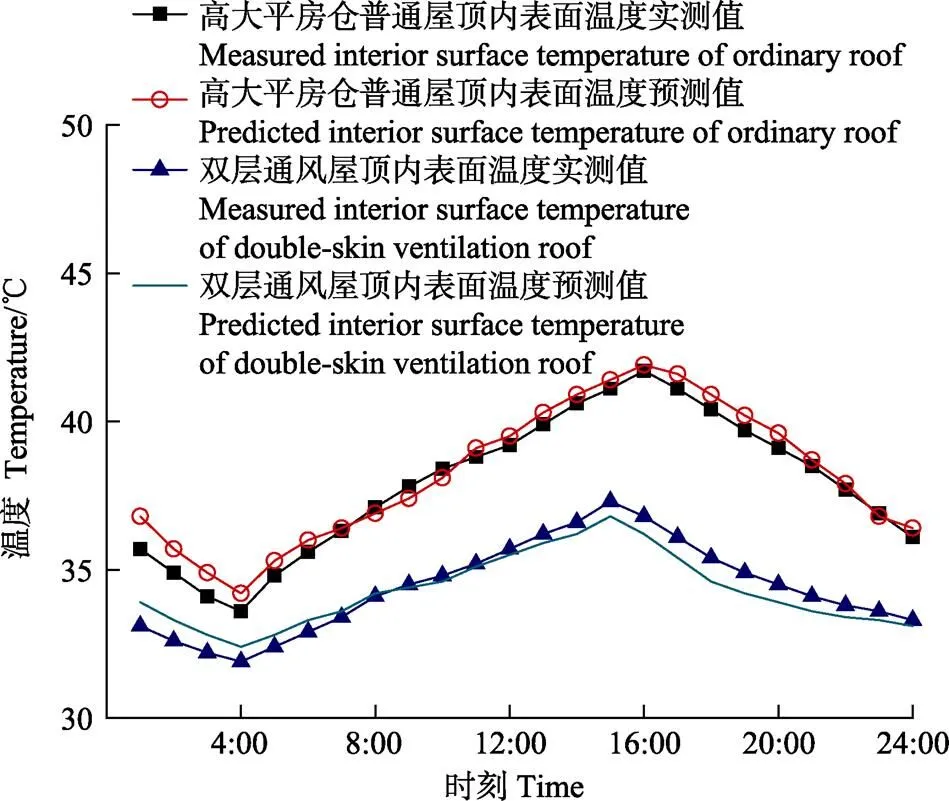
注:温度测量时间为2017年7月30日,2017年7月29日温度测量的平均值作为传热模型验证时的屋顶初始温度。
1.4 粮仓屋顶冷负荷引起的空调能耗费用计算
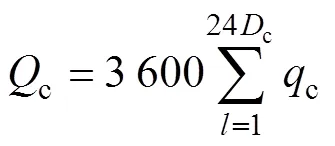

2 粮仓屋顶P1-P2经济性模型分析方法

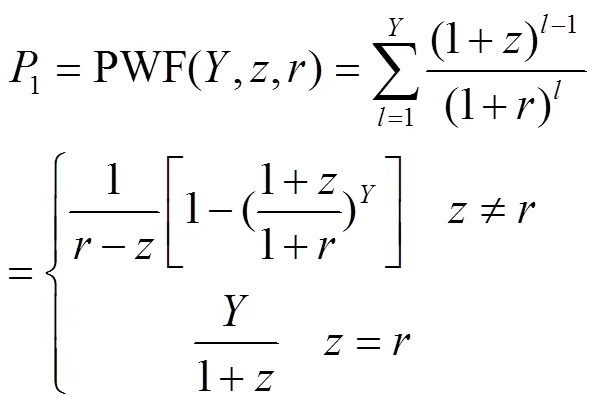
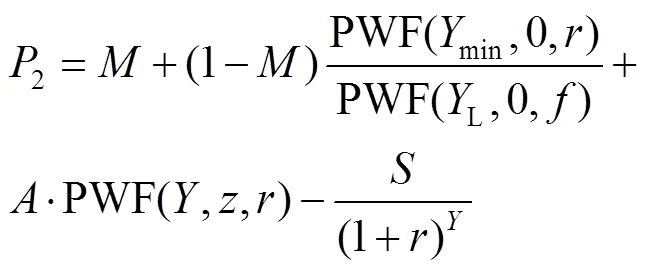
单位面积粮仓屋顶保温隔热层的建设成本可用式(14)表示。






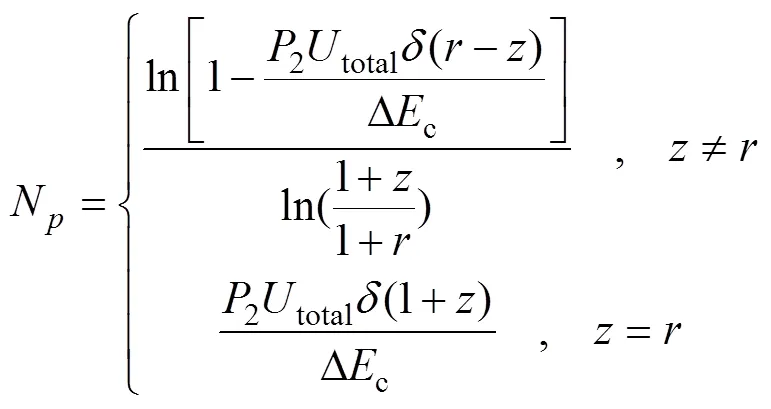
3 粮仓屋顶最佳保温隔热层厚度计算
本研究利用经过验证的粮仓屋顶传热模型预测粮仓屋顶冷负荷引起的空调系统能耗费用,采用1-2经济分析模型进行综合考虑建设成本和空调系统能耗费用的粮仓屋顶全生命周期经济性分析,研究长沙地区低温粮仓屋顶不同外表面太阳辐射反射率的最佳保温隔热层厚度和双层通风屋顶最佳保温隔热层厚度。本研究以具有典型夏热冬冷气候特征的长沙地区为例,结合长沙地区的真实低温粮仓进行低温粮仓屋顶最佳保温隔热层厚度研究。长沙地区的产粮以稻谷为主,低温储粮是抑制稻谷有害生物体生长繁殖和延缓稻谷品质劣变的最佳方法。低温储粮具有很好的安全储粮效果,但需要安装运行能耗较高的制冷空调系统。本研究涉及的低温粮仓安装了能效比为2.3的空调系统。每年4月—11月为需要粮仓空调系统制冷的月份。每年5月—9月粮仓空调系统全天24 h间歇运行,以便保证稻谷的储粮安全。每年4月、10月和11月为过渡月份,利用小功率轴流风机进行适宜室外气象条件的通风降温,实现粮仓过渡月份的通风节能。

利用式(14)和式(15)计算长沙地区低温粮仓屋顶不同保温隔热层厚度的生命周期内总投资现值。图4为粮仓屋顶外表面太阳辐射高反射率、中反射率和低反射率时生命周期内总投资现值随挤塑聚苯乙烯和膨胀聚苯乙烯保温隔热层厚度的变化情况。随着屋顶外表面太阳辐射反射率的减小,生命周期内总投资现值逐渐增加。当屋顶外表面为太阳辐射高反射率时,挤塑聚苯乙烯和膨胀聚苯乙烯的生命周期内总投资最小现值分别为137.29和129.56元/m2。当屋顶外表面为太阳辐射中反射率时,挤塑聚苯乙烯和膨胀聚苯乙烯的生命周期内总投资最小现值分别为181.15和157.36元/m2。当屋顶外表面为太阳辐射低反射率时,挤塑聚苯乙烯和膨胀聚苯乙烯的生命周期内总投资最小现值分别为193.29和167.82元/m2。挤塑聚苯乙烯的生命周期内总投资最小现值为137.29~193.29元/m2,膨胀聚苯乙烯的生命周期内总投资最小现值为129.56~167.82元/m2。双层通风屋顶的挤塑聚苯乙烯和膨胀聚苯乙烯的生命周期内总投资最小现值分别为256.71和233.35元/m2。
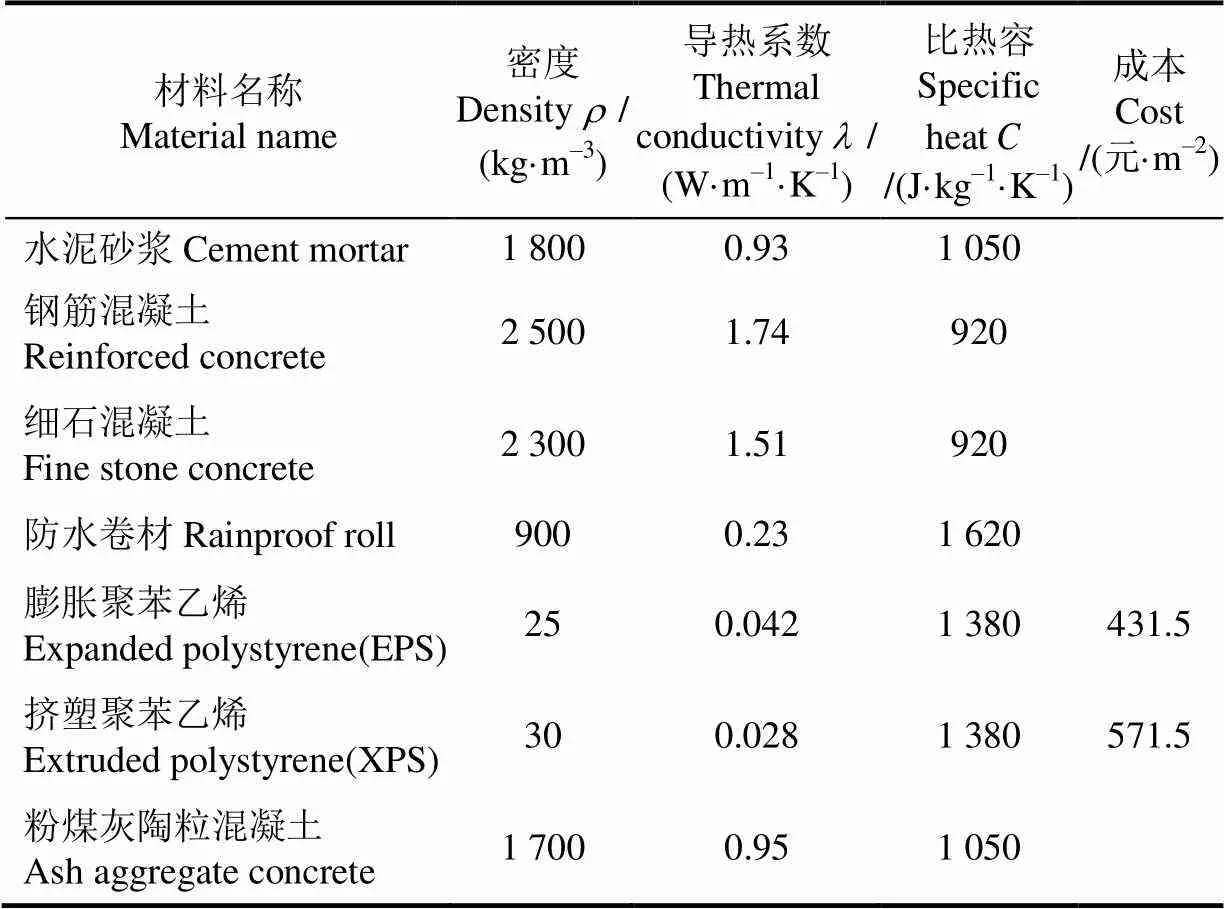
表1 屋顶材料特性参数
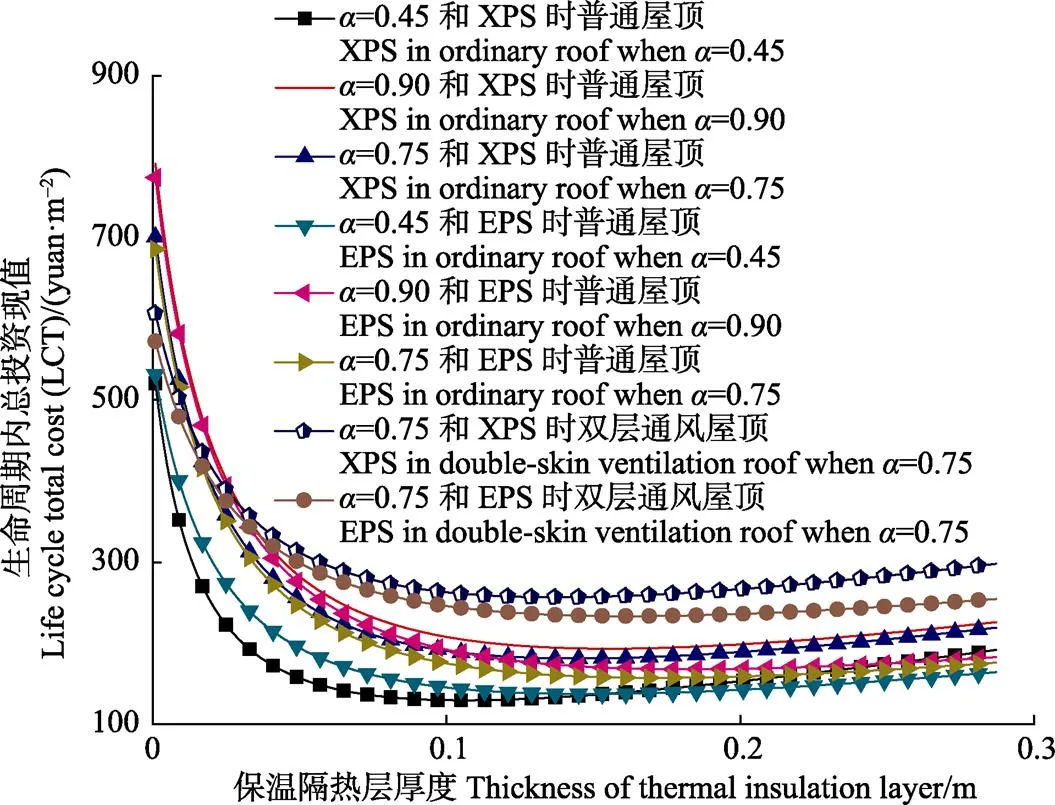
注:a是太阳能辐射热吸收系数;屋顶外表面为太阳辐射高反射率表面时a=0.45;屋顶外表面为太阳辐射中反射率表面时a=0.75;屋顶外表面为太阳辐射低反射率表面时a=0.90;双层通风屋顶外表面为太阳辐射中反射率表面时a=0.75。
利用式(14)和式(16)计算长沙地区低温粮仓屋顶不同保温隔热层厚度的生命周期内净现值(即生命周期内净收益)。图5给出了粮仓屋顶外表面太阳辐射高反射率、中反射率、低反射率时生命周期内净现值随挤塑聚苯乙烯和膨胀聚苯乙烯保温隔热层厚度的变化情况。随着屋顶外表面太阳辐射反射率的减小,生命周期内净现值逐渐减小。当屋顶外表面为太阳辐射低反射率时,挤塑聚苯乙烯和膨胀聚苯乙烯的生命周期内最大净现值分别为417和424.7元/m2。当屋顶外表面为太阳辐射中反射率时,挤塑聚苯乙烯和膨胀聚苯乙烯的生命周期内最大净现值分别为534.67和558.46元/m2。当屋顶外表面为太阳辐射高反射率时,挤塑聚苯乙烯和膨胀聚苯乙烯的生命周期内最大净现值分别为607.9和633.38元/m2。挤塑聚苯乙烯的生命周期内最大净现值为417~607.9元/m2, 膨胀聚苯乙烯的生命周期内最大净现值为424.7~ 633.38元/m2。双层通风屋顶的挤塑聚苯乙烯和膨胀聚苯乙烯的生命周期内最大净现值分别为458.98和482.47元/m2。

图5 不同保温隔热层厚度的生命周期内净现值
当生命周期内净现值最大时,粮仓屋顶保温隔热层厚度为最佳保温隔热层厚度。图6给出了粮仓屋顶外表面太阳辐射高反射率、中反射率和低反射率时挤塑聚苯乙烯和膨胀聚苯乙烯最佳保温隔热层厚度。随着屋顶外表面太阳辐射反射率的减小,最佳保温隔热层厚度逐渐增加。当屋顶外表面为太阳辐射高反射率时,挤塑聚苯乙烯和膨胀聚苯乙烯的最佳保温隔热层厚度分别为0.106和0.148 m。当屋顶外表面为太阳辐射中反射率时,挤塑聚苯乙烯和膨胀聚苯乙烯的最佳保温隔热层厚度分别为0.145和0.171 m。当屋顶外表面为太阳辐射低反射率时,挤塑聚苯乙烯和膨胀聚苯乙烯的最佳保温隔热层厚度分别为0.154和0.183 m。挤塑聚苯乙烯最佳保温隔热层厚度为0.106~0.154 m,膨胀聚苯乙烯最佳保温隔热层厚度为0.148~0.183 m。双层通风屋顶的挤塑聚苯乙烯和膨胀聚苯乙烯的最佳保温隔热层厚度分别为0.137和0.167 m。当屋顶外表面为太阳辐射中反射率时,双层通风屋顶的最佳保温隔热层厚度小于高大平房仓普通屋顶最佳保温隔热层厚度。
确定长沙地区低温粮仓屋顶最佳保温隔热层厚度之后,可以利用式(18)计算长沙地区低温粮仓屋顶最佳保温隔热层厚度的投资回收年限。图7给出了粮仓屋顶外表面太阳辐射高反射率、中反射率和低反射率时挤塑聚苯乙烯和膨胀聚苯乙烯最佳保温隔热层厚度的投资回收年限。随着屋顶外表面太阳辐射反射率的减小,挤塑聚苯乙烯和膨胀聚苯乙烯最佳保温隔热层厚度投资回收年限均逐渐减小。当屋顶外表面为太阳辐射高反射率时,挤塑聚苯乙烯和膨胀聚苯乙烯最佳保温隔热层厚度投资回收年限分别为2.96和2.68 a。当屋顶外表面为太阳辐射中反射率时,挤塑聚苯乙烯和膨胀聚苯乙烯最佳保温隔热层厚度投资回收年限分别为2.71和2.47 a。当屋顶外表面为太阳辐射低反射率时,挤塑聚苯乙烯和膨胀聚苯乙烯最佳保温隔热层厚度投资回收年限分别为2.62和 2.39 a。挤塑聚苯乙烯最佳保温隔热层厚度投资回收年限为2.62~2.96 a,膨胀聚苯乙烯最佳保温隔热层厚度投资回收年限为2.39~2.68 a。双层通风屋顶挤塑聚苯乙烯和膨胀聚苯乙烯最佳保温隔热层厚度投资回收年限分别为2.67和2.37 a。当屋顶外表面为太阳辐射中反射率时,高大平房仓双层通风屋顶比普通屋顶具有更小的投资回收年限。
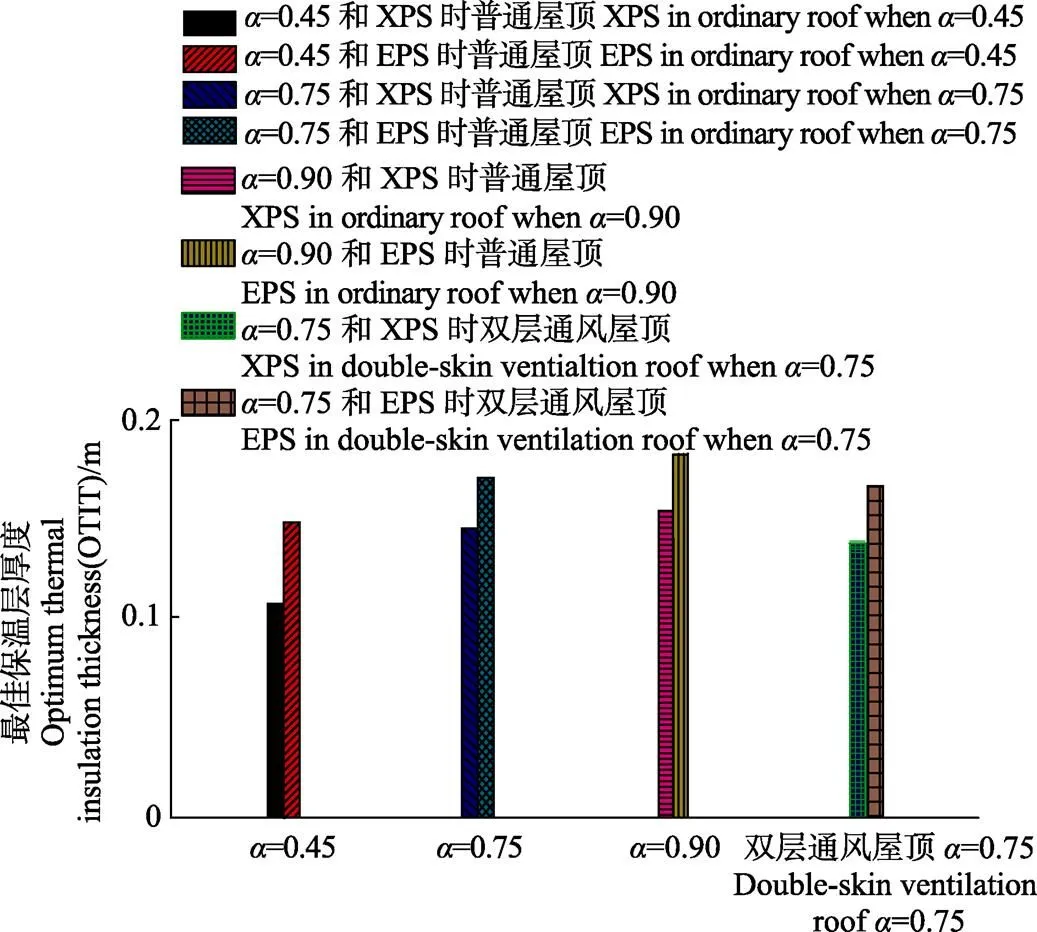
图6 最佳保温隔热层厚度

图7 最佳保温隔热层投资回收年限
4 结 论
1)膨胀聚苯乙烯最佳保温隔热层厚度大于挤塑聚苯乙烯最佳保温隔热层厚度,膨胀聚苯乙烯保温隔热层比挤塑聚苯乙烯保温隔热层有更短的投资回收年限。长沙地区低温粮仓普通屋顶最佳保温隔热层厚度范围为0.106~0.183 m,生命周期内最大净现值范围为417~633.38元/m2,投资回收年限为2.39~2.96 a。长沙地区低温粮仓屋顶采用膨胀聚苯乙烯比挤塑聚苯乙烯更具经济优越性。
2)外表面太阳辐射反射率对长沙地区低温粮仓屋顶最佳保温隔热层厚度有较大影响,长沙地区低温粮仓屋顶保温隔热工程设计应考虑屋顶外表面太阳辐射反射率的影响。随着粮仓屋顶外表面太阳辐射反射率的减小,粮仓屋顶最佳保温隔热层厚度逐渐增加,挤塑聚苯乙烯保温隔热层和膨胀聚苯乙烯保温隔热层的投资回收年限均逐渐减少,因此长沙地区低温粮仓普通屋顶应采用太阳辐射高反射率的屋顶外表面,低温粮仓屋顶外表面喷高反射率的隔热涂料可以起到较显著的节能减排效果。
3)高大平房仓双层通风屋顶可以减少长沙地区低温粮仓屋顶最佳保温隔热层厚度,减少屋顶保温隔热层投资回收年限,长沙地区低温粮仓可以采用双层通风屋顶来降低粮仓能耗。长沙地区低温粮仓采用双层通风屋面仍需设置一定厚度的保温隔热层,才能达到理想的经济效果和节能减排效果。
4)本文虽然仅以长沙地区为例进行案例分析,但主要是从方法上来分析研究粮仓屋顶最佳保温隔热层厚度,文中所提出的研究方法可推广应用到全国不同气候区域和不同的保温隔热材料,对提高低温粮仓保温隔热性能,优选保温隔热材料,实现储粮安全和粮仓节能减排具有重要指导意义。
[1] 李新宇,熊旭波,张岩,等. 热管低温储粮技术对小麦品质的影响[J]. 中国粮油学报,2015,30(1):107-111. Li Xinyu, Xiong Xubo, Zhang Yan, et al. Effect of heat pipe-based low-temperature grain storage technology on wheat quality[J]. Journal of the Chinese Cereals and Oils Association, 2015, 30(1): 107-111. (in Chinese with English abstract)
[2] 修方珑,张岩,王世清,等. 基于热管技术的储粮仓温度特征及其抑虫效果[J]. 农业工程学报,2013,29(14): 256-261. Xiu Fanglong, Zhang Yan, Wang Shiqing, et al. Temperature characteristic and inhibition effect on insect pest in grain storehouse based on heat pipe technology[J]. Transactions of the Chinese Society of Agricultural Engineering (Transactions of the CSAE), 2013, 29(14): 256-261. (in Chinese with English abstract)
[3] 曹哲,施正香,安欣,等. 基于热成像技术的牛舍围护结构传热阻测试方法[J]. 农业工程学报,2017,33(24): 235-241. Cao Zhe, Shi Zhengxiang, An Xin, et al. Evaluation on measure method of heat transfer resistance for enveloped structure of cattle barn based on infrared imaging method[J]. Transactions of the Chinese Society of Agricultural Engineering (Transactions of the CSAE), 2017, 33(24): 235-241. (in Chinese with English abstract)
[4] 王世清,张岩,姜文利,等. 热管技术在自然冷源蓄冷中的应用[J]. 农业工程学报,2010,26(4):312-316. Wang Shiqing, Zhang Yan, Jiang Wenli, et al. Application of heat pipe technology in ice storage of natural coldness resource[J]. Transactions of the Chinese Society of Agricultural Engineering (Transactions of the CSAE), 2010, 26(4): 312-316. (in Chinese with English abstract)
[5] 艾全龙. 粮仓新型保温隔热吊顶材料效果研究[J]. 粮食储藏,2006,35(4):30-32. Ai Quanlong. Study on effect of new type heat preservation and insulating fir material ceiling of grain warehouse[J]. Grain Storage, 2006, 35(4): 30-32. (in Chinese with English abstract)
[6] 徐卫华,刘春华. 改造仓房进行储粮的应用情况分析[J].粮食储藏,2006,35(1):40-41.Xu Weihua, Liu Chunhua. Application of rebuilt warehouse in grain storage[J]. Grain Storage, 2006, 35(1): 40-41. (in Chinese with English abstract)
[7] Yu J H, Yang C Z, Tian L W, et al. A study on optimum insulation thicknesses of external walls in hot summer and cold winter zone of China[J]. Applied Energy, 2009, 86(11): 2520-2529.
[8] Cay Y, Gürel A E. Determination of optimum insulation thickness, energy savings, and environmental impact for different climatic regions of Turkey[J]. Environmental Progress and Sustainable Energy, 2013, 32(2): 365-372.
[9] Derradji L, Imessad K, Amara M, et al. A study on residential energy requirement and the effect of the glazing on the optimum insulation thickness[J]. Applied Thermal Engineering, 2017, 112: 975-985.
[10] Mohsen M S, Akash B A. Some prospects of energy savings in buildings[J]. Energy Conversion and Management , 2012, 42(11): 1307-1315.
[11] Keçebaş A. Determination of optimum insulation thickness in pipe for exergetic life cycle assessment[J]. Energy Conversion and Management, 2015, 105: 826-835.
[12] Lee S, Park S H, Yeo M S, et al. An experimental study on airflow in the cavity of a ventilated roof [J]. Building and Environment, 2009, 44(7): 1431-1439.
[13] Kurekci N A. Determination of optimum insulation thickness for building walls by using heating and cooling degree-day values of all Turkey’s provincial centers[J]. Energy and Buildings, 2016, 118: 197-213.
[14] Ciampi M, Leccese F, Tuoni G. Energy analysis of ventilated and microventilated roofs[J]. Solar Energy, 2005, 79(2): 183-192.
[15] Qu J, Song J R, Qin J, et al. Transparent thermal insulation coatings for energy efficient glass windows and curtain walls[J]. Energy and Buildings, 2014, 77(7): 1-10.
[16] 于靖华,田利伟,杨昌智. 夏热冬冷地区居住建筑屋顶保温层最佳厚度分析[J]. 中南大学学报:自然科学版,2012,43(4):1545-1550.Yu Jinghua, Tian Liwei, Yang Cangzhi. Analysis on optimum insulation thickness of residential roof in hot summer and cold winter zone[J]. Journal of Central South University (Science and Technology), 2012, 43(4): 1545-1550. (in Chinese with English abstract)
[17] 刘向伟,郭兴国,陈国杰,等. 建筑外墙最佳保温厚度及环境影响研究[J]. 湖南大学学报:自然科学版,2017,44(9):182-187. Liu Xiangwei, Guo Xingguo, Chen Guojie, et al. Optimum insulation thickness of exterior wall and its environment impacts. [J]. Journal of Hunan University: Natural Sciences, 2017, 44(9): 182-187. (in Chinese with English abstract)
[18] Yin Y Y, Qi R, Zhang H Y, et al. Microstructure design to improve the efficiency of thermal barrier coatings[J]. Theoretical and Applied Mechanics Letters, 2018, 8(1): 18-23.
[19] Comakli Kemal, Yuksel Bedri. Environmental impact of thermal insulation thickness in buildings[J]. Applied Thermal Engineering, 2004, 24(5/6): 933-940.
[20] Axaopoulos P, Panagakis P, Axaopoulos I. Effect of wall orientation on the optimum insulation thickness of a growing-finishing piggery building[J]. Energy and Buildings, 2014, 84: 403-411.
[21] Ozel Meral. Cost analysis for optimum thicknesses and environmental impacts of different insulation materials[J]. Energy and Buildings, 2012, 49(2): 552-559.
[22] Omar A I, Virgone J, Vergnault E, et al. Energy Saving Potential with a double-skin roof ventilated by natural convection in Djibouti[J]. Energy Procedia, 2017, 140: 361-373.
[23] Barbosa S, Ip K, Southall R. Thermal comfort in naturally ventilated buildings with double skin façade under tropical climate conditions: The influence of key design parameters [J]. Energy and Buildings, 2015, 109: 397-406.
[24] Perilli S, Sfarra S, Guerrini M, et al. The thermo physical behavior of cork supports doped with an innovative thermal insulation and protective coating: A numerical analysis based on in situ experimental data [J]. Energy and Buildings, 2018, 159: 508-528.
[25] Yin H, Guo H F, Lin Z R, et al. Determining optimum insulation thickness by thermoeconomic analysis for a pipeline system in a subway central cooling system[J]. Applied Thermal Engineering, 2018, 136: 454-461
[26] Bar-Cohen A, Rohsenow W M. Thermally optimum spacing of vertical, natural convection cooled, parallel plates[J]. Journal of Heat Transfer, 1984, 106(1): 116-123.
[27] Olsson C. Prediction of nusselt number flow rate of buoyancy driven and flow between vertical parallel plastes [J]. Journal of Heat Transfer, 2004, 126(1): 97-104.
[28] Lam J, Li D. Correlation between global radiation and its direct and diffuse components[J]. Building and Environment, 1996, 31(6): 827-535.
[29] Duffle John, Beckman William A. Solar energy thermal processes[M]. New York: Wiley, 1991.
Analysis of optimum thermal insulation thickness of double-skin ventilation roof of low temperature granary in Changsha region
Wang Haitao, Wang Jun, Guo Chengzhou
(450001,)
The thermal insulation performance of granary envelope has important impacts on grain storage safety and granary energy consumption. The roof of a granary is usually very large. Because roof is the position with the strongest solar radiation in granary, the external heat is mainly transferred into granary through roof. Therefore, granary roof is the key part in the design of thermal insulation in building envelope of granary. Double-skin ventilation roof, high reflectivity coatings for roof, and thermal insulation material are three popular techniques for roof of granary for stored grain safety and more energy saving. According to different solar radiation levels and different climatic characteristics, the optimum thermal insulation thicknesses of roofs is different in different areas of China. In this paper, the transient heat transfer model of multi-layer roof was presented and validated for calculating energy consumption of ordinary roof in low temperature granary. By considering the influence of natural ventilation, a heat transfer model of double-skin ventilation roof was proposed and validated for determining energy consumption of double-skin ventilation roof. In this pater, the1-2economic models were used to study the optimum thermal insulation thicknesses of the ordinary multi-layer roof and the double-skin ventilation roof of the low temperature granaries in Changsha region. The effect of different solar radiation reflectivity rates of outside surface was considered in determining the optimum thermal insulation thickness of the low temperature granary roof in Changsha region. The optimum thermal insulation thicknesses of two thermal insulation materials including expanded polystyrene and expanded polystyrene were calculated for ordinary roof and double-skin ventilation roof of the low temperature granary in Changsha region by using1-2economic model respectively. And then, on the basis of life cycle cost analysis, the total life cycle costs, life cycle savings and payback periods were calculated. The results of this research showed that the solar radiation reflectivity of outside surface has a significant impact on the economy and the optimum thermal insulation thickness of the low temperature granary roof in Changsha region. Double-skin ventilation roof can reduce the optimum thermal insulation thickness of low temperature granary roof. Double-skin ventilation roof and high reflectivity coatings for roof should be adopted in roof of low temperature granary in Changsha region for more energy saving and less environmental pollution. The optimum thermal insulation thicknesses range of extruded polystyrene and expanded polystyrene was between 0.106-0.183 m for ordinary roof of low temperature granary. The maximum life cycle savings range from 417 to 633.38 RMB Yuan/m2. The payback period ranges from 2.39 to 2.96 years for the optimum thermal insulation thickness of roof. Expanded polystyrene has thicker optimum thermal insulation layer than extruded polystyrene. Expanded polystyrene has shorter payback period of optimum thermal insulation thickness of roof than extruded polystyrene. The optimum thermal insulation thickness of the roof decreases with the increase of the solar radiation reflectivity of outside surface of the roof. The double-skin ventilation roof can shorten the payback period of the optimum thermal insulation thickness of the low temperature granary roof. Besides, this determination method of optimum thermal insulation thickness of roof has a certain guiding significance for guiding design process of thermal insulation thickness of low temperature granary roof.
heat transfer; thermal insulation; model; roof; solar radiation; optimum thickness; life cycle
10.11975/j.issn.1002-6819.2018.19.035
TU111.4
A
1002-6819(2018)-19-0276-08
2018-06-12
2018-08-17
国家自然科学基金(51406048);国家粮食公益性行业科研专项(201513001);河南工业大学创新人才基金项目 (2015RCJH17)
王海涛,副教授,博士,主要从事建筑热湿传递特性研究。Email:haitao-wangshd@163.com
王海涛,王 军,郭呈周. 长沙地区低温粮仓双层通风屋顶最佳保温隔热层厚度分析[J]. 农业工程学报,2018,34(19):276-283. doi:10.11975/j.issn.1002-6819.2018.19.035 http://www.tcsae.org
Wang Haitao, Wang Jun, Guo Chengzhou. Analysis of optimum thermal insulation thickness of double-skin ventilation roof of low temperature granary in changsha region[J]. Transactions of the Chinese Society of Agricultural Engineering (Transactions of the CSAE), 2018, 34(19): 276-283. (in Chinese with English abstract) doi:10.11975/j.issn.1002-6819.2018.19.035 http://www.tcsae.org

